Hurricanes Irma and Maria struck massive damage across the Caribbean this year. In disaster recovery situations, the Internet is critical communications infrastructure. In this article, we look at the observable network effects on Puerto Rico in the aftermath of hurricane Maria.
Maria directly impacted Puerto Rico, making landfall as a Category 4 hurricane. Puerto Rico was not not the only island impacted this year, but the impact on a population of this island's size is of particular note.
It's worth understanding that the status of infrastructure on the ground in Puerto Rico is very different to what we can observe from the outside. Co-locations and submarine cable landings will have backup generators to keep them running for days or weeks after a power outage. We know that most of the island lost power, and most of the island lost cell connectivity. More detailed information is being posted regularly to NANOG by Sean Donelan.
If you're willing and able to provide assistance to Puerto Rico, resources for doing so can be found at centropr.hunter.cuny.edu and pbs.org.
The timeline
From the network data, we have two main signals that map well onto understanding how connectivity on the island was affected: we have a small number of RIPE Atlas probe hosts on the island, and we have BGP announcements from ASNs registered in Puerto Rico.
Once the hurricane reached the island, the impact on infrastructure was abrupt. The high-level timeline looks like this:
- 18 Sept, 21:00UTC: hurricane warning posted; some networks start to drop announcements
- 20 Sept, 07:00UTC: hurricane wind speeds were consistently hitting the island. RIPE Atlas probes also start to go offline. From this point, significant network disruption occurs.
- 20 Sept, 10:15UTC: the hurricane makes landfall
- 20 Sept, 16:00UTC: the hurricane leaves the island
- 21 Sept, 01:00UTC: wind speeds drop across the island
- 21 Sept, 03:00UTC: hurricane warning discontinued. Networks and probes continue to go offline as power fails.
BGP Visibility
The most obvious observable effect across the event is the rapid reduction in the number of prefixes announced from Puerto Rican-registered ASNs. We can pull out the timeseries here, with subplots for some of the networks that announce many prefixes:
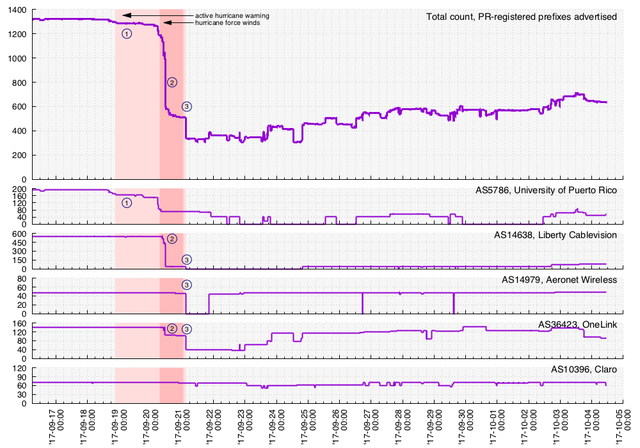
Strictly from the BGP feed aggregated from RIPE RIS peers, and using the set of ASNs registered in Puerto Rico, we see the following (bullet numbers are marked in the plot):
-
From around 18 September at 16:00UTC through 20 September around 03:00UTC, AS5786 (the University of Puerto Rico) gradually dropped various announcements before a significant drop before the hurricane made landfall.
-
Around 11:30UTC that day, some or all announcements were simultaneously dropped from various ASNs, including AS14638 (Liberty Cablevision) and AS36423 (OneLink). (Note, that OneLink is owned by Liberty.) At this point, it appears that Liberty's BGP announcements dropped via most transits except AS11992. Some of OneLink's announcements via Liberty drop around the same time, but other AS paths remain visible.
- Another simultaneous drop occurred on 21 September, around 03:10UTC, including the remaining announcements from Liberty (all remaining paths via AS 11992). OneLink's, paths via AS23520 are withdrawn at this point. All announcements from AS14979 (Aeronet Wireless), are also withdrawn at this point, its visible upstream also AS23520.
A count of the announced prefixes doesn't quite tell us everything we want to know. It can be useful to visualise the impact spatially, to help see which parts of the address space were reachable and whether covering prefixes stayed in place.
Below you can see a different view of the address space: each horizontal line here indicates an announcement from the Puerto Rican-registered ASNs when the announcements were active. Each ASN is delineated by a different colour, and some of the larger contributors are labelled on the right-hand side of the plot. Overlapping prefixes occupy the same space on the y-axis, though may not be drawn to scale, so this depicts how individual prefixes behaved but continues to indicate when a part of the address space was reachable even if a more-specific prefix is withdrawn:
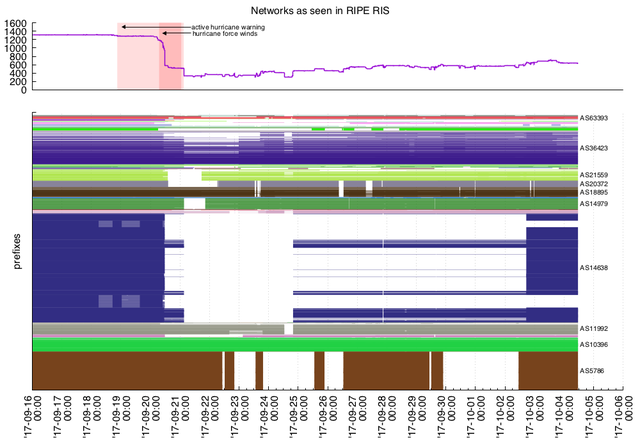
The scope of the impact is clearly visible. Most networks were unable to maintain consistent external connectivity, either in the immediate aftermath of the hurricane or the subsequent days. But their behaviour was not identical.
Broadly, the event led to the withdrawal of most of Puerto Rico's address space:
- We observed announcements from 48 ASNs before the hurricane made landfall, and 26 afterwards. That is, 22 ASNs went offline. 15 ASNs continued announcing the same address space without significant impact.
- The number of actual announced prefixes originating from these ASNs dropped from 1249 to 335.
The address space since has fluctuated, though moving towards recovery. In some cases, such as the ASN5786, connectivity still appears to be intermittent.
RIPE Atlas probe connectivity
RIPE Atlas probe connectivity reflects the timeline above. Most of the probes failed in the hours around the hurricane, when the power grid was badly affected as you can see in the image below:

We don't have a large number of RIPE Atlas probes located on the island; five probes covering four ASNs. We see AS5786 (University of Puerto Rico), AS14638 (Liberty), and AS36423 (OneLink) as above; none of these have connected back to us since the hurricane. Lack of power or other structural damage may be the cause.
Only one probe has since reconnected, inside AS36810, the Gauss Research Laboratory, who happen to be responsible for the .pr top-level domain.
Ongoing Recovery
As of writing this article,
- 42 ASNs are announcing address space, down from 48 before the hurricane, but up from the minimum observed of 26.
- 614 prefixes are being announced, a little less than half of the announcements that were active before the hurricane.
- Four RIPE Atlas probes remain offline.
This is an improvement of what we observed almost two weeks ago when almost three quarters of all prefixes were withdrawn. Some networks still appear unstable but most appear to have at least some reachability, albeit in a situation where many inhabitants may still not have power. It's clear from the data that people are working hard to put things back together; connectivity and availability are continuing to evolve. We'll keep looking at what we observe via BGP and RIPE Atlas, and we'll update when it's appropriate.
Finally, events such as this help us understand how to better visualise and share the data we have. We're working on prototypes to help visualise probe status, and we want to provide more interactive tooling to help people understand outages with RIPE Atlas. We'll be talking more about this in a future RIPE Labs article.

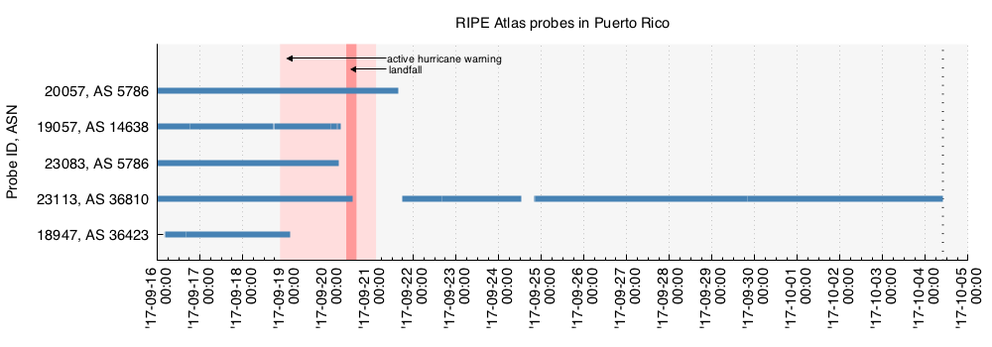
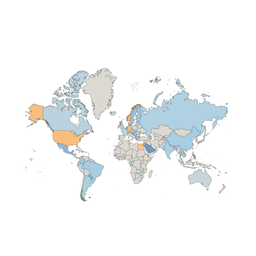

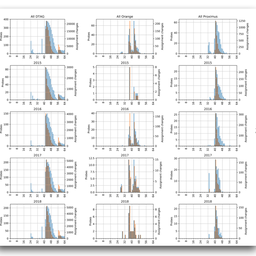
Comments 0
The comments section is closed for articles published more than a year ago. If you'd like to inform us of any issues, please contact us.